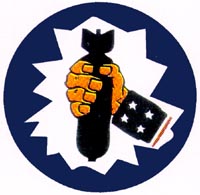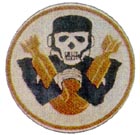|
Soon
after Pearl Harbor 1941, the sneak attack that the late President
Franklin D Roosevelt called "A Day of Infamy", the 310th was organized
and was activated in March 1942. The 310th
was designated as a medium bomber Group consisting of four squadrons.
Each squadron had 6-two engine B-25 Mitchell aircraft. The versatile
B-25 was named after General William "Billy" Mitchell one of America's
key architects of air power. The 310th Bomb Group was made up of four
squadrons: the 379th, 380th, 381st, and the 428th.
From the burning sands of Tunisia and Libya to the
snow covered Italian Alps the Group flew combat missions. They suffered
in desert temperatures of 118 or more with the only shade provided were
the wings of their aircraft or the pup tents in which they slept. These
U.S. Airmen bivouacked in the cork forests of North Africa, survived
the monsoon floods of Cape Bon, the German air raids and the buzzing
hordes of malaria- laden mosquitoes of Corsica. It was no vacation
haven.
The group participated in the invasions of North
Africa, Sicily, Salerno, Anzio, and Southern France. Battle Honors and
Battle Stars were repeatedly earned for combat action in the Tunisian,
Sicilian, Naples/Foggia, Rome/Arno, Southern France, North Appennines,
Central Europe and Po Valley Campaigns as well as two Distinguished
Unit Citations for meritorious action. No combat group was involved in
more European Theater of Operations invasions than the 310th.
Some of the heroic stories about low-level missions
against enemy shipping by the 379th squadron in North Africa and the
Greek Islands were so dramatic that they reached the ears of General
James Doolittle... he had to see for himself. Doolittle 'signed up' for
a low-level sea sweep mission in February 1943, which netted three
Seibel Ferries and confirmed his belief in these 75mm cannon toting
aircraft.
That same month the 310th
sank an enemy tanker, a heavily armed freighter, one German cruiser,
eight Seibel Ferries and knocked down 10 German aircraft. Doolittle had
used the versatile B-25s to bomb Tokyo in April 1942 and while they had
no squadron or group designation, eight of the Doolittle Raiders would
later wind up with the 310th in North Africa, December 1942.
When the 57th Bomb Wing intelligence learned that an
enemy tanker, escorted by a cruiser and two destroyers was bound for
Tunisia an attack was ordered. The 310th
was assigned the task and flying no higher than 100 feet the B-25s
attacked. The first element scored some hits on the tanker while the
second element struck the three-escort ships. The tanker was set afire,
the cruiser sank stern first and the two destroyers were severely
damaged.
One mission from North Africa to the mainland of
Italy called for 36 of the 310th aircraft to bomb a key transportation
center near Naples. On their way to the target 50 enemy fighters
intercepted and attempted to divert the B-25 formations, it didn't
work. The target, railroad marshalling yards, was destroyed and 18 of
the attacking fighters were shot down. But the victory was costly for
the 310th. Three of our aircraft were downed, and the remaining ships
returned to base riddled with flak and machine gun bullet holes. This
mission earned one of the two Distinguished Unit Citations for the
310th. Another thumbs up for victory.
In March 1943 the 321st. Bomb Group flew its first
combat mission while the 340th Bomb Group flew its first mission a
months later just as the 310th completed 52 combat missions. These
three groups of B-25s were part of the 12th Air Force.
Eighteen B-25s, while on a routine sea sweep
after German shipping, ran into a Luftwaffe aerial convoy off the coast
of Cape Bon in North Africa flying at about 200 feet off the ocean. The
convoy of 25 German transports and a dozen or so ME 210's and other
assorted aircraft was completely destroyed by the 310th. The B-25s
circled and ranged up and down the German convoy utterly devastating
the flight. The accompanying P-38 fighters finished the task. On that
April 1943 "Turkey Shoot" the 310th claimed 10 JU 52's
and a JU 88 shot down.
In June 1943 Pantelleria Island surrendered to air
power, the first such capitulation to air power ever recorded. Shortly
after, the island of Lampedusa also surrenders to air power displayed
by the devastating medium bombers of the 12th AAF.
The group was stationed in such exotic named places
as: Mediouna, French Morocco, Masion Blanche, Telergma, and Berteaux,
Algeria, Dar el Koudia, Tunisia, Souk el Arba, and Valle
(Phillipville), Algeria, Oudna, and Menzel Temime, Tunisia, Gambut,
Libya, Ghisonnacia Gare, Corsica, Fano, and Pomiglano, Italy.
In late 1943 B-25-Gs arrived in the 310th.
These awesome planes were the most heavily armed aircraft in the world.
They were equipped with a 75mm cannon and fourteen .50 caliber machine
guns. The 310th was destined to be the only "gunslinger" group in the
theater. These aircraft had been developed and used extensively in the
South Pacific with much success and it was felt that they could be used
against German shipping just as effectively. The 379th squadron was
used to comply with the requirements of Winston Churchill to assist the
British defend the Dodecanese, (Greek Islands) against the Germans.
Thus, these low-level attacks, in the Greek Islands flown by a squadron
of the 310th from Lybia, was the definitive answer.
When moving operations from North Africa to Corsica
at the end of the African Campaign the mission role of the 310th
changed from strategic and tactical bombardment to the familiar role of
only tactical attacks. While the 379th squadron pursued their low-
level sea sweeps in the Greek Islands, the other three squadrons kept
up attacks in the destruction of German transportation and
communications.
January 1944 saw the 428th Squadron flying the first
of the low-level sea sweeps from the Island of Corsica. These attacks
against coastal installations and shipping resulted in high losses from
flak and fighters in the group.
The 310th Bomb Group was the first bomb group in the European
Theater of Operations to complete 500 combat missions which occurred
July 7, 1944.
An operation called "Strangle", the choking of
German communications, ships, harbors, railroads and their yards,
airfields, supply dumps and other targets initiated in 1944 zeroed in
on the bridges of Italy. Knocking them down and in that way cut the
flow of men, equipment and supplies to the German front lines and
eventually lead to the enemy retreating.
Group strength under the command of Col. Anthony
Hunter was 1,319 men and 72 aircraft. While the ground battle continued
to move north, the 310th
took part in operation "Anvil", the invasion of Southern France. As
battle lines were condensed by the German retreat into the Po Valley
and Brenner Pass, anti aircraft fire became more intense and
concentrated. Even so we continued to hit our targets. Just as it had
been all through Italy the targets were bridges, often pontoon or
makeshift crossings constructed overnight by the Germans
In October 1944, Col. Hunter transferred to
Headquarters and Col. Peter H. Remington became commander of the 310th.
The final mission, number 989, for the group came in
May 1945. The 310th would end its World War II activities with the
distinction of having flown the greatest number of combat missions of
any medium bomber group in the Mediterranean Theater. The mission was a
leaflet drop mission announcing the unconditional surrender of the
enemy. It was at that time Col. William Bower assumed command of the
310th and initiated preparations for our return to the United States
and mom's home cooking.
The group was deactivated on September 12, 1945 from
their final station at Pomigliano, Italy. Ten days earlier (September
2, 1945) the Japanese signed unconditional surrender aboard the U.S S.
Missouri. In addition to the presence of General Douglas MacArthur and
other high ranking military officers, was our own General Doolittle. |
|





 The 310th Space Group is located at Schriever AFB, Colorado and was
activated on September 1, 1997 at Falcon Air Force Base, Colorado. The
group reports directly to 10th Air Force. The mission of the 310 SG is
to provide command and control for Department of Defense and Department
of Commerce satellites and to provide security for terrestrial based
14th Air Force assets.
The 310th Space Group is located at Schriever AFB, Colorado and was
activated on September 1, 1997 at Falcon Air Force Base, Colorado. The
group reports directly to 10th Air Force. The mission of the 310 SG is
to provide command and control for Department of Defense and Department
of Commerce satellites and to provide security for terrestrial based
14th Air Force assets.